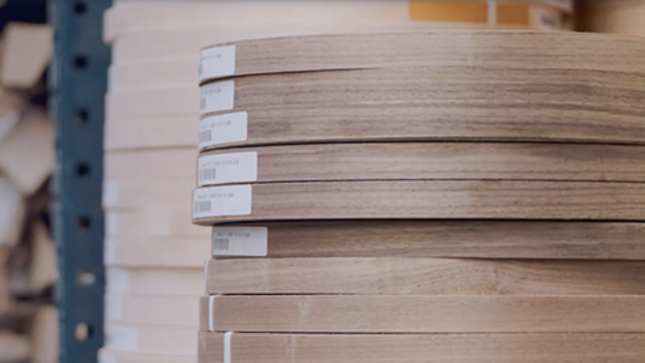
In the world of custom furniture design, every detail contributes to the overall aesthetic and functionality of a piece. One such detail, often overlooked, is the choice of edgebanding. Veneer edgebanding, in particular, has emerged as a favored option among designers and craftsmen. This article delves into the versatility of veneer edgebanding in custom furniture design, highlighting its benefits, applications, and the reasons for its widespread use.
What is Veneer Edgebanding?
Veneer edgebanding is a thin strip of wood veneer used to cover the exposed edges of plywood, particleboard, or MDF (medium-density fiberboard) in furniture and cabinetry. It is made from real wood, which gives it a natural and authentic appearance. Veneer edgebanding is available in various wood species, grains, and finishes, allowing for a wide range of design possibilities.
Benefits of Veneer Edgebanding
1. Natural Aesthetic: Veneer edgebanding offers a genuine wood appearance, which is essential for achieving a high-end, luxurious look. The natural grain patterns and textures of the wood add warmth and richness to furniture pieces.
2. Design Flexibility: With veneer edgebanding, designers can choose from numerous wood species, including oak, maple, cherry, walnut, and more. This variety allows for matching the edgebanding with the main material of the furniture, ensuring a seamless and cohesive look.
3. Eco-Friendly: Veneer edgebanding is an environmentally friendly option. It uses less wood than solid wood edgebanding, making it a more sustainable choice. Additionally, many manufacturers source their veneers from responsibly managed forests.
4. Easy to Work With: Veneer edgebanding is relatively easy to apply using heat or adhesive methods. It conforms well to curves and edges, making it suitable for intricate and detailed designs.
5. Cost-Effective: While providing the look and feel of solid wood, veneer edge banding is more cost-effective. It allows for high-quality finishes without the high price tag associated with solid wood.
Applications of Veneer Edgebanding in Custom Furniture Design
1. Cabinetry: In custom cabinetry, veneer edgebanding is used to cover the raw edges of cabinet doors, drawers, and shelves. This not only enhances the appearance of the cabinets but also protects the edges from damage and wear.
2. Tables and Desks: Veneer edgebanding is commonly used in the design of tables and desks. It provides a smooth, finished look to the edges, ensuring that the furniture is both functional and aesthetically pleasing.
3. Shelving Units: Custom shelving units benefit from veneer edgebanding as it gives them a polished and professional appearance. The edgebanding can be matched with the shelves' surface for a uniform look.
4. Wardrobes and Closets: In wardrobes and closets, veneer edgebanding adds a touch of elegance to the storage spaces. It enhances the visual appeal and ensures that the furniture complements the overall design of the room.
5. Accent Furniture: Veneer edgebanding is also used in accent furniture pieces such as side tables, consoles, and bookshelves. It allows for creative and unique designs that stand out while maintaining a cohesive look with other furniture pieces.
The Versatility of Veneer Edgebanding
The versatility of veneer edgebanding lies in its ability to adapt to various design styles and applications. Whether designing a modern, minimalist piece or a classic, traditional furniture item, veneer edgebanding can be tailored to meet specific aesthetic and functional requirements.
1. Modern and Minimalist Designs: For sleek, modern designs, veneer edgebanding provides clean lines and a smooth finish. It can be paired with high-gloss surfaces or matte finishes to achieve a contemporary look.
2. Traditional and Rustic Designs: In traditional and rustic furniture, veneer edgebanding adds warmth and character. The natural wood grain and texture enhance the charm and authenticity of the pieces.
3. Custom Patterns and Inlays: Veneer edgebanding allows for custom patterns and inlays, enabling designers to create unique and personalized furniture. This adds an element of exclusivity and craftsmanship to the design.
4. Color Matching and Contrasting: Designers can choose veneer edgebanding that matches the main material for a seamless look or opt for contrasting edgebanding to create a striking visual effect. This flexibility opens up numerous design possibilities.
Conclusion
Veneer edgebanding plays a crucial role in the world of custom furniture design. Its natural aesthetic, design flexibility, eco-friendliness, ease of application, and cost-effectiveness make it a preferred choice for designers and craftsmen. Whether used in cabinetry, tables, shelving units, or accent furniture, veneer edgebanding enhances the beauty and functionality of the pieces. Its versatility allows for endless creative possibilities, ensuring that each custom furniture item is unique and tailored to the specific needs and preferences of the client. As design trends continue to evolve, veneer edgebanding remains a timeless and valuable component in the creation of beautiful, high-quality furniture.